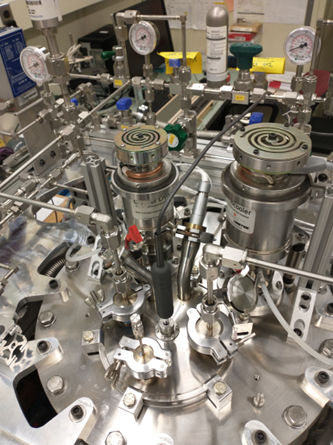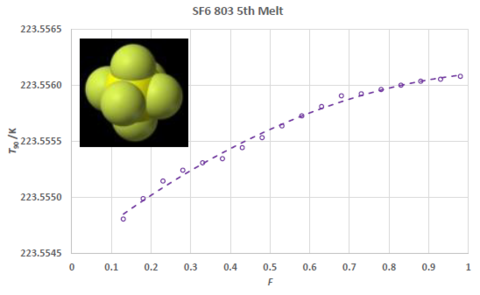Summary
We are developing new fixed points and new maintenance systems for use with Standard Platinum Resistance Thermometers (SPRTs) below the triple point of water (273.16 K). These fixed points enable realization of the International Temperature Scale (ITS 90) as currently defined as well as new alternative realizations. The alternative realizations are needed to address regulatory issues concerning the use of elemental mercury. In addition, maintenance systems based on cryocooler technologies are being developed to support current requirements for use of the argon triple point (Ar TP) as well as potential future applications with other noble non-metals.
Description
A fixed point is a reproducible reference temperature, usually either melting of freezing of a pure substance, that allows a standardized interpolation scheme for the purposes of temperature scale dissemination. Most SPRTs are long-stem designs that require immersion-type fixed points incorporating a long narrow thermowell. New fixed points and new maintenance system technologies are needed to address the problems with use of mercury as a fixed point on the ITS-90 (Hg TP, 234.3156 K). The non-metal triple points of sulfur hexafluoride (SF6 TP, 223.556 K) and carbon dioxide (CO2 TP, 216.592 K) are two candidate substances on which NIST is conducting research with various prototype immersion-type cells. These two triple points are at a sufficiently high temperatures for the use of conventional refrigerated-bath technologies to enable the triple-point realizations. Other strategies for replacing the Hg TP on the ITS-90 include use of the triple point of xenon (Xe TP, 161.406 K). In this case newer technologies based on closed-cycle cryocoolers are needed to enable the realization of this lower temperature fixed point.
These projects are organized under a common programmatic theme: Advanced Realizations of Cryogenic Phase Equilibria Temperatures (ARCPET).
Objective
To support the full set of ITS-90 subranges below 273.16 K, starting from 13.8 K, non-metal fixed point cells and special realization techniques are required. To address the regulatory restrictions specific to mercury, we develop non-metal fixed points suitable for substitution of the Hg TP on the ITS-90 in two temperature ranges. 1. Triple points in the range between 200 K and 230 K where drop-in replacements may operate using conventional refrigerated bath technologies. 2. Triple points in a lower range between 70 K and 200 K where vacuum systems using closed-cycle helium cryocoolers are necessary for the fixed-point maintenance system.
Technical approach

1. Drop-in Replacement Fixed Points (200 K to 230 K):
In this temperature range, many suitable commercial solutions are available for the maintenance systems in the form of refrigerated metrology baths. However, there are no commercial sources for non-metal immersion fixed point cells that could substitute for the Hg TP. NIST is focusing on the development of re-fillable immersion-type cell designs using a.) SF6 and b.) CO2. Our prototype designs (see Fig 1) incorporate valves and integrated ballast volumes sufficient for achieving storage pressures (at 295 K) under 6 MPa. Our initial results with a series of prototype SF6 triple point cells yielded a combined standard uncertainty of 0.35 mK in the ITS-90 temperature, of which the uncertainty of the Hg TP realization was a dominant contribution.

2. Fixed points using New Technologies for use below 200 K:
In this range, the only commercial fixed points currently available are immersion-type argon triple point cells. All of these systems utilize pool-boiling liquid nitrogen (l-N2) as the refrigeration for an integrated maintenance system. This approach limits the achievable stability, duration, and ultimate reproducibility of the Ar TP. In contrast, the NIST approach is to utilize highly compact and reliable Sterling-type cryocoolers in a multiple-zone maintenance system that can be optimized for any fixed point from 70 K to 200 K. The NIST prototype system now under construction (See Fig 2) utilizes two small sterling cryocoolers in closed-loop configurations with a total of four active control zones to achieve stable melting plateaus of noble non-metals for indefinite durations. The technology will be demonstrated using an immersion-type Ar TP cell that accommodates both capsule-type and long-stem SPRTs.
3. Fixed points for capsule-type thermometers below 84 K:
In the lowest SPRT subrange of the ITS-90, only capsule-type SPRTs are utilized, and small sealed triple-point cells are maintained at NIST for scale maintenance purposes. In this case, the realization methods are essentially adiabatic through the use of vacuum calorimeters. These include those cells for the realization of the triple point of a.) argon b.) oxygen, c.) neon, and d.) equilibrium-hydrogen.
Major Accomplishments
- In April 2023 we presented our performance data on the new prototype system for use in the realization of the argon triple point. A poster was presented at the 10th International Temperature Symposium in Anaheim CA.
- In March of 2021 a US Patent Application was published, “Triple Point Immersion Cell Article”, US 2021/0072098 A1, for a NIST-developed technology that applies Sterling cryocooler technologies for the maintenance of immersion-type triple point cells.
-

In 2019, we achieved stable melting plateaus with a NIST prototype immersion-type CO2 TP cell using a quasi-adiabatic method and determined a preliminary value for the triple point temperature of 216.5910(5) K on the ITS-90 at a melted fraction of F=0.5. We also performed a replication of our earlier work on SF6 using a new SF6 cell with a different gas source, as realized via a quasi-adiabatic method: T90=223.55608(50) K at a melted fraction of F=1. These results were presented at the XIV International Symposium on Temperature and Thermal Measurements in Industry and Science & IV International Temperature Conference, Beijing (TEMPMEKO & TEMPBEIJING 2019) held from June 10 to 14, 2019 in Chengdu, China.
- In 2018, we published our results using a set of two NIST immersion-type SF6 TP cells and two other NIST adiabatic-type cells and determined an average triple-point temperature of T90=223.55607(35) K at a melted fraction of F=1.
- In 2016 NIST became the first lab to demonstrate stable melting plateaus using an immersion-type triple-point cell with SF6.
- In 2012 the results of an international comparison of sealed triple point cells was published which included several NIST sealed triple point cells.

